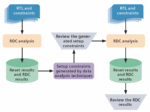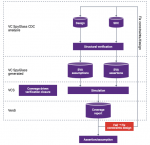You are currently viewing SemiWiki as a guest which gives you limited access to the site. To view blog comments and experience other SemiWiki features you must be a registered member. Registration is fast, simple, and absolutely free so please,
join our community today!
Description
Clock domain crossings (CDCs) are a critical aspect of FPGA and embedded system design, and handling them correctly is essential for reliable operation. In this one-hour webinar, we’ll break down CDC fundamentals, explore best practices for managing single-bit and bus CDCs, and demonstrate how to leverage Xilinx… Read More
The complexity of System-on-Chip (SoC) designs continues to rise at an accelerated rate, with design complexity doubling approximately every two years. This increasing complexity makes verification a more difficult and time-consuming task for design engineers. Among the key verification challenges is managing reset domain… Read More
SoC designs frequently have lots of different clock domains to help manage power more efficiently, however one side effect is that when the clock domains meet, i.e., in a Clock Domain Crossing (CDC), there’s the possibility of setup and hold time violations that can cause a flip-flop to become metastable. Synchronizer … Read More
I’m a fan of DVCon, a fan of Accellera and a fan of Munich, hosting DVCon Europe once again. This year’s event runs from November 14th through 15th (with some events on the 16th) at the Holiday Inn Munich in the City Center. Phillippe Notton (CEO, SiPearl) will deliver a keynote on “Energy Efficient High-Performance Computing in the… Read More
Accellera sponsored a luncheon panel discussion at #60DAC, so I registered and attended to learn more about one of the newest working groups for Clock Domain Crossing (CDC). An overview of Accellera was provided by Lu Dai, then the panel discussion was moderated by Paul McLellan of Cadence, with the following panel members:
…
Read More
Manish Pandey, VP R&D and Fellow at Synopsys, gave the keynote this year. His thesis is that given the relentless growth of system complexity, now amplified by multi-chiplet systems, we must move the verification efficiency needle significantly. In this world we need more than incremental advances in performance. We need… Read More
Sivakumar P R is the Founder and CEO of Maven Silicon. He is responsible for the company’s vision, overall strategy, business, and technology. He is also the Founder and CEO of Aceic Design Technologies.
Sivakumar is a seasoned engineering professional who has worked in various fields, including electrical engineering,… Read More
Clock domain crossing (CDC) analysis is unavoidable in any modern SoC design and is challenging enough to verify in its own right. CDC plus low power management adds more excitement to your verification task. I wrote on this topic for another solution provider last year. This time I want to intro an interesting twist on the problem,… Read More
Talking not so long ago to a friend from my Atrenta days, I learned that the great majority of design teams still run purely structural CDC analysis. You should sure asynchronous clock domains are suitably represented in the SDC, find all places where data crosses between those domains that require a synchronizer, gray-coded FIFO… Read More
Synopsys just released a white paper, a backgrounder on CDC. You’ve read enough of what I’ve written on this topic that I don’t need to re-tread that path. However, this is tech so there’s always something new to talk about. This time I’ll cover a Synopsys survey update on numbers of clock domains in designs, also an update on ways to… Read More








